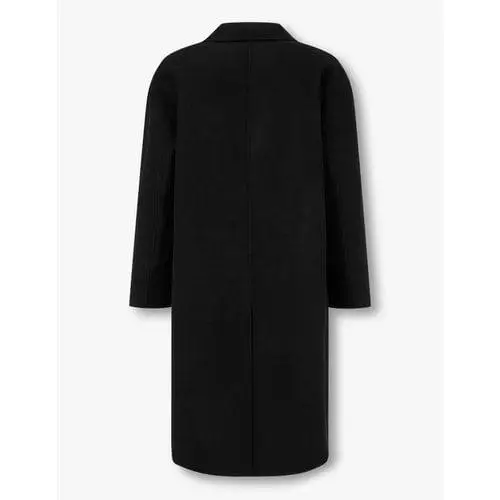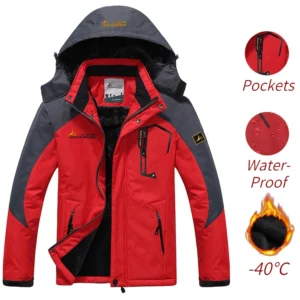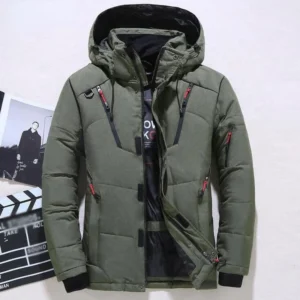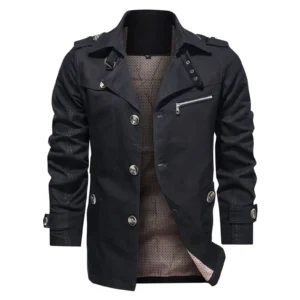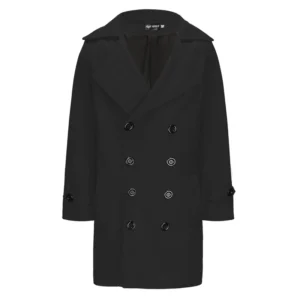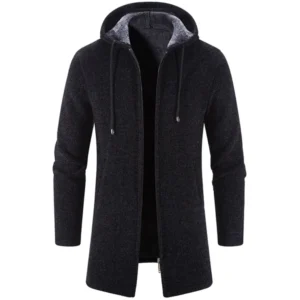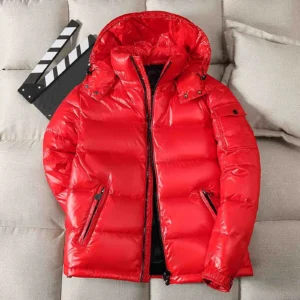Why a Wool Car Coat Is Your Essential Winter Investment
When winter arrives with its biting winds and dropping temperatures, a wool car coat stands as the perfect blend of practicality and sophistication. These mid-thigh length coats with their structured silhouette were originally designed with a specific purpose in mind—providing warmth and comfort while allowing ease of movement for early automobile drivers. Today, they’ve evolved into a winter essential for the modern man.
This guide will take you through everything you need to know about wool car coats for the winter season—from understanding their unique design features to selecting the perfect one for your needs. Whether you’re navigating city streets during your daily commute or attending formal winter gatherings, the right wool car coat delivers exceptional performance.
What makes wool car coats particularly suited for winter wear is their impressive warmth-to-weight ratio. Unlike bulkier alternatives, a well-crafted wool car coat creates natural insulation through wool’s unique fiber structure, trapping heat close to the body while still allowing breathability. This remarkable balance makes these coats versatile enough for both casual weekend outings and more formal business settings.
The unmatched benefits of wool car coats extend beyond just warmth. Their natural wind resistance shields you from harsh winter gusts, while their moisture-wicking properties keep you comfortable even when moving between outdoor cold and heated indoor environments. This adaptability makes them particularly valuable for active urban lifestyles.
Our recommendations throughout this guide are based on extensive material analysis, consultations with fabric experts, and real-world wearer experiences. We’ve assessed everything from wool quality to construction techniques to help you make an informed investment in your winter wardrobe.
Understanding Wool Car Coats: Design & Material Excellence
A. Defining Characteristics of a Proper Car Coat
A true car coat occupies the sweet spot in winter outerwear—longer than a jacket but shorter than a full-length overcoat. Typically falling to mid-thigh (about 30-36 inches or 76-91 cm in length), these coats strike the perfect balance between coverage and mobility. This length is no accident; it was specifically designed to offer protection from the elements while allowing comfortable movement when sitting in a vehicle.
What truly distinguishes a proper car coat are its thoughtful design elements. Most feature notched lapels or stand collars that can be turned up for additional neck protection on particularly cold days. Pocket placement is strategic—typically slash or flap pockets positioned at a comfortable height for warming hands while maintaining a clean silhouette. The closure systems often include concealed plackets to prevent wind penetration.
While car coats share certain features with other winter outerwear, they have distinct differences from pea coats and other styles. Pea coats tend to be shorter (typically ending at hip level) with broader lapels and a more nautical aesthetic. Overcoats extend below the knee with a more formal appearance, while trench coats feature belts and storm flaps designed for rainy conditions rather than extreme cold.
The car coat’s design specifically accommodates driving needs with features like:
– Raglan or set-in sleeves with enough room for arm movement to control a vehicle
– Slightly fuller cut across the shoulders and back to prevent binding when reaching for controls
– Split vents or pleated action backs that allow for comfortable sitting
– Higher armholes for unrestricted movement
These practical design elements make wool car coats particularly suitable for active winter wear, whether you’re driving, commuting, or simply navigating daily urban life.
B. Wool as the Superior Winter Coat Material
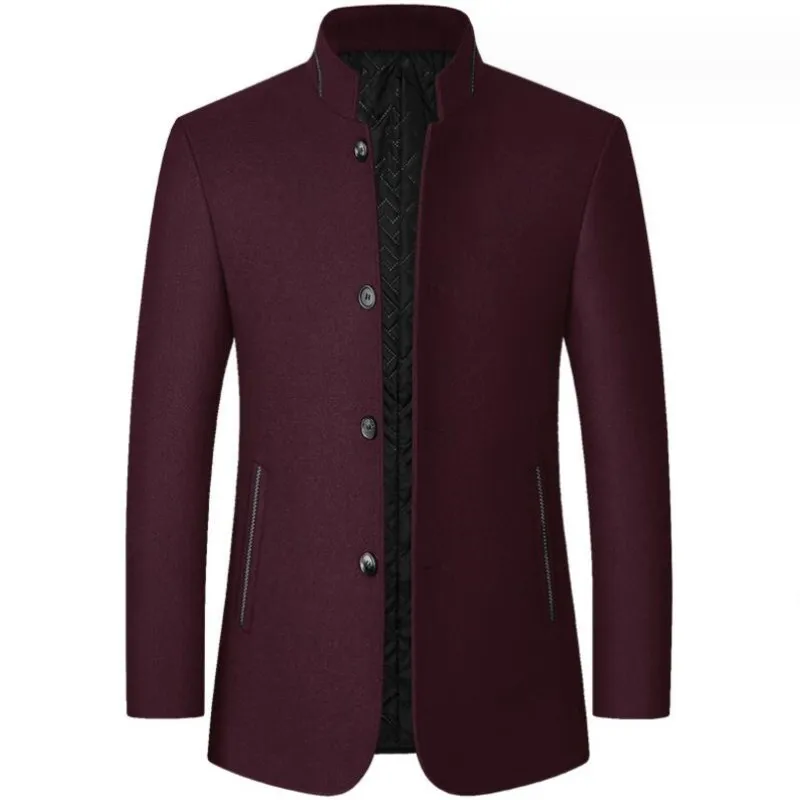
When it comes to winter outerwear, wool stands head and shoulders above other materials thanks to its remarkable natural properties. The secret to wool’s exceptional performance lies in its complex fiber structure—each strand contains thousands of microscopic air pockets that trap body heat while allowing moisture vapor to escape. This natural architecture creates superior insulation without the bulk of synthetic alternatives.
The science behind wool’s thermal efficiency is fascinating. Wool fibers have a natural crimp or wave pattern that creates tiny air spaces, functioning as nature’s insulation. Even more impressive, wool generates small amounts of heat through a chemical reaction when absorbing moisture, which is why it keeps you warm even in damp conditions—a crucial benefit during unpredictable winter weather.
Different types of wool offer varying benefits in car coat construction:
| Wool Type | Characteristics | Best For |
|---|---|---|
| Merino | Extremely fine fibers (under 24 microns), exceptionally soft, lightweight warmth | Luxury coats with maximum comfort |
| Melton | Dense, tightly woven, substantial weight, excellent wind resistance | Durable everyday coats for harsh conditions |
| Lambswool | Soft, resilient, harvested from young sheep | Coats that balance comfort and durability |
| Wool Blends | Combined with cashmere for softness or synthetic fibers for durability and reduced price | Value-oriented options or specific performance needs |
The percentage of wool in a coat’s fabric composition significantly impacts its performance. While 100% wool coats offer maximum natural benefits, quality blends (typically containing 70-90% wool) can enhance certain properties like wrinkle resistance or reduce cost without significantly compromising warmth. Higher wool content generally translates to better insulation, more effective moisture management, and longer-lasting performance.
Wool’s natural advantages extend beyond just keeping you warm. Its moisture-wicking ability moves sweat away from your body to evaporate, preventing the chilling effect of damp fabric against skin. Additionally, wool contains lanolin, which provides natural water resistance and antimicrobial properties, helping wool coats keep you remarkably warm while resisting odors even after multiple wearings.
For those interested in exploring the full range of options, Metro Cloak’s collection of wool coats showcases these materials in various styles and weights suitable for different winter conditions.
Expert Buying Guide: Selecting Your Ideal Wool Car Coat
A. Evaluating Warmth Performance & Insulation Features
The warmth of a wool car coat isn’t just about thickness—it’s determined by several key factors working in harmony. Fabric weight, measured in grams per square meter (GSM), provides a reliable indicator of insulation potential. Lighter coats (around 400-500 GSM) offer moderate warmth suitable for milder winters or active lifestyles, while heavyweight options (700-900 GSM, or approximately 20-32 oz) deliver maximum protection in frigid conditions.
Construction techniques significantly influence a coat’s insulating abilities. Double-faced wool, where two layers are woven together without a separate lining, creates exceptional warmth with a clean, refined appearance. Single-layer wool with strategic lining can offer similar insulation while sometimes providing more flexibility in movement.
When evaluating lining materials, consider these options:
- Thinsulate or similar synthetic insulation: Adds significant warmth with minimal bulk
- Flannel lining: Provides soft comfort and additional insulation
- Silk lining: Creates a smooth, luxurious feel with surprising warmth for its weight
- Quilted lining: Traps additional air for improved insulation
Matching your coat to your climate is essential for comfort. For severe winter regions, prioritize heavier weights with wind-resistant features like plackets that cover the closure, storm flaps, and tightly woven outer fabrics. In more moderate climates, lighter weights allow for comfortable layering strategies with your wool car coat without overheating.
Wind resistance deserves special attention, as even the warmest coat can feel ineffective in gusty conditions if not properly designed. Look for tightly woven outer fabrics, overlapping closures, and protective collars that can be secured against the neck. These features, combined with wool’s natural wind-resistant properties, create effective protection against winter’s bite.
For those wanting to explore the full spectrum of winter protection, Metro Cloak’s winter coat collection offers options ranging from lightweight transitional pieces to heavy-duty cold-weather defenders.
B. Achieving Perfect Fit & Flattering Silhouette
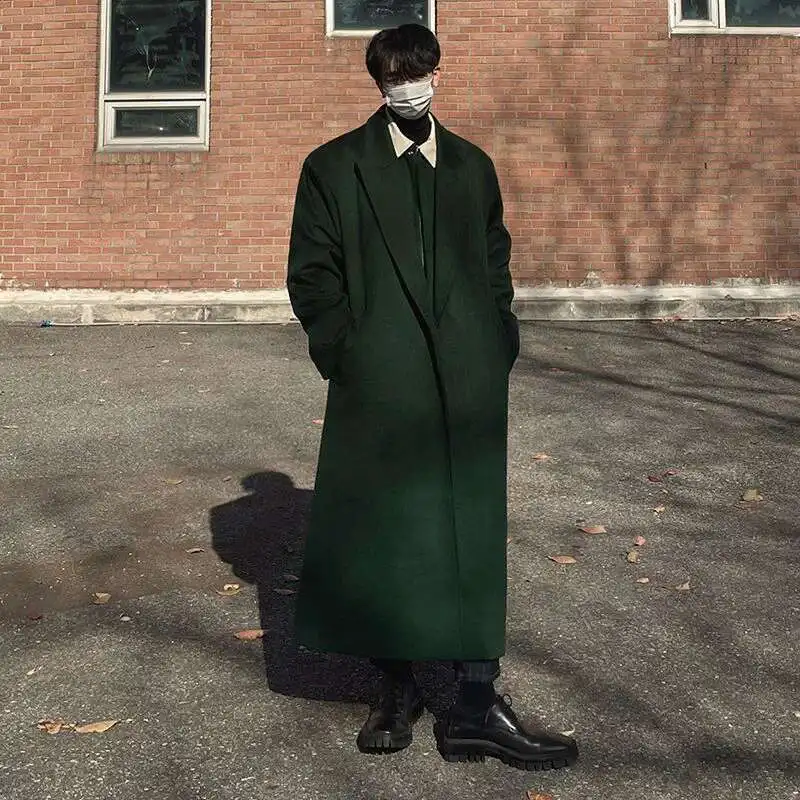
A well-fitted wool car coat enhances both comfort and appearance, making fit one of the most critical considerations in your purchase. When evaluating fit, start with the shoulders—they should align with your natural shoulder edge without pulling or excessive roominess. Sleeves should end at your wrist bone, allowing about ¼-½ inch (0.6-1.3 cm) of suit or shirt sleeve to show when arms are at rest.
Proper length is essential for both proportion and function. The ideal car coat typically falls to mid-thigh, covering suit jackets completely while maintaining mobility. Taller men might prefer slightly longer coats, while shorter frames often benefit from slightly shorter lengths to maintain visual balance. Choosing the right coat length makes a significant difference in how flattering the garment appears on your frame.
When trying on wool car coats, always test the fit while wearing clothing similar to what you’ll typically wear underneath. For coats intended for business wear, try them on over a suit jacket or blazer to ensure comfortable layering. The coat should close smoothly with enough room for layers but without excess fabric that creates a bulky appearance.
Different silhouettes suit different body types:
– Athletic builds typically benefit from moderately tailored silhouettes that follow body lines without constriction
– Slender frames can wear both fitted and slightly oversized styles, with the latter adding visual bulk
– Broader builds usually look best in clean, classic lines that create structure without excessive tapering
A simple fit test involves these movements: buttoning the coat completely, crossing your arms, reaching forward, and sitting down. If you experience significant pulling, restriction, or collar gap during these actions, consider trying a different size or cut.
Remember that slight tailoring can transform an almost-perfect coat into an ideal one. Sleeve length and waist suppression are relatively simple alterations that can dramatically improve fit, making a modest additional investment worthwhile for a garment you’ll wear for years.
C. Selecting Style Elements for Versatility
The style elements of your wool car coat determine not just its appearance but also its versatility across different settings and outfits. Collar design significantly influences both function and formality—notched lapels offer a classic, versatile look suitable for most occasions, while stand collars provide greater neck protection with a more contemporary, streamlined aesthetic. Convertible collars that can be worn either flat or standing up offer maximum versatility for changing conditions.
Closure types balance practical function with visual impact. Traditional button fronts with 3-5 buttons create a classic appearance suitable for both business and casual wear. Hidden plackets (where buttons are concealed behind a fabric panel) offer cleaner lines and improved wind resistance. Toggle closures bring a more casual, heritage-inspired look that pairs well with weekend attire.
Color selection dramatically affects a coat’s versatility. Timeless neutrals like charcoal gray, navy blue, and camel create the foundation of a versatile wardrobe, easily coordinating with most outfits. Darker colors generally read as more formal and show less wear, while medium tones like camel or olive green bring visual interest while remaining versatile.
For those who already have a basic neutral coat, consider these secondary color options:
– Deep burgundy or oxblood for sophisticated style with subtle distinction
– Olive green for versatile earth tones that coordinate with most wardrobes
– Medium gray for a softer alternative to charcoal that pairs well with both formal and casual wear
Fabric patterns add character while affecting versatility. Herringbone patterns offer subtle texture that maintains formality while adding visual interest. Twill weaves create diagonal lines that catch light beautifully while remaining appropriate for professional settings. Check patterns introduce more casual character, with smaller checks maintaining greater versatility than larger, bolder designs.
The styling potential of wool car coats spans from weekend casual to business formal, with specific style elements helping position your coat appropriately on this spectrum. For maximum versatility, consider a single-breasted design with notched lapels in a solid neutral color—this configuration transitions seamlessly between jeans and sweaters or suits and ties.
Those interested in pattern options might explore Metro Cloak’s herringbone coat collection for designs that add texture while maintaining sophisticated versatility.
D. Assessing Quality & Craftsmanship Indicators
The quality of construction in a wool car coat directly affects not only its appearance but also its longevity and performance in harsh winter conditions. When examining potential purchases, pay particular attention to seam construction. Premium coats feature flat-felled seams with double rows of stitching or well-executed overlocked seams that prevent fraying while maintaining a clean interior appearance. Seam allowances should be generous, providing material for potential alterations.
Button quality serves as another reliable indicator of overall craftsmanship. Superior coats use natural materials like horn or corozo nut rather than plastic, with buttons securely attached using a shank construction that accommodates the thick wool fabric. The highest quality garments feature buttons that are cross-stitched for durability, with a proper distance from the edge to prevent tearing.
Lining construction deserves careful inspection as it affects both comfort and longevity. Quality coats feature linings attached with sufficient ease to allow movement without stress on the seams. Look for “floating” linings that are secured at strategic points rather than fully fused to the outer fabric, allowing independent movement between layers. Proper lining construction includes pleats at the back shoulder and vents to accommodate body movement.
Pocket construction reveals much about a coat’s quality level. Premium coats feature pockets reinforced at stress points with clean, symmetrical placement. Internal pockets should be thoughtfully positioned and constructed with appropriate materials—lighter weight fabrics for phone pockets to prevent screen damage, sturdier materials for heavier items.
When handling a potential purchase, these physical tests can reveal quality levels:
– Gently pull at seams to check for tight, uniform stitching without gaps
– Examine button attachment by lightly tugging to ensure secure fastening
– Check collar construction for proper interfacing that creates a smooth roll without bubbling
– Inspect lining attachment at vents and hems for clean finishing and appropriate ease
The quality spectrum reflects genuine differences in materials, construction techniques, and expected longevity. While higher prices generally correlate with better quality, informed assessment of these construction details helps identify the best wool car coats that provide value at any price point.
Top Wool Car Coat Recommendations for Men
A. Premium Investment Pieces: Exceptional Quality & Craftsmanship
For those seeking the pinnacle of wool car coat excellence, these premium options represent true investment pieces designed to provide decades of service with proper care. These exceptional coats combine superior materials with meticulous craftsmanship to create outerwear that performs brilliantly while developing character with age.
The Metropolitan Classic
* Materials: 100% Merino wool at 750 GSM with silk-blend lining
* Construction Highlights: Hand-stitched buttonholes, pick-stitched lapels, fully canvassed construction
* Design Elements: Clean notched lapels, four-button front with concealed placket, hand-warmer pockets plus two interior security pockets
* Fit Profile: Classic silhouette with moderate room for layering; available in regular and long lengths
* Color Options: Charcoal, navy, camel, and deep olive
* Value Proposition: Though commanding a premium price, this coat represents exceptional value through its superior materials, construction designed for decades of wear, and timeless styling that resists trends
The Executive Commuter
* Materials: 90% wool/10% cashmere blend at 680 GSM with Bemberg lining
* Construction Highlights: Half-canvas construction, reinforced stress points, seam allowances that permit tailoring adjustments
* Design Elements: Convertible collar for weather adaptability, leather-trimmed welt pockets, interior media pocket with headphone port
* Fit Profile: Contemporary silhouette with shaped waist; accommodates suit jackets comfortably
* Color Options: Navy herringbone, charcoal twill, and camel
* Value Proposition: Blends luxury touches with practical features for the urban professional; the cashmere content adds significant softness without compromising durability
These investment pieces represent significant value despite their higher price points through their exceptional material quality, construction techniques that enhance longevity, and timeless design that transcends seasonal trends. While requiring greater initial investment, they typically offer lower cost-per-wear over their extended lifespan.
For those interested in exploring the highest tier of wool quality, Metro Cloak’s cashmere overcoat collection offers premium options that combine exceptional softness with surprising durability.
B. Outstanding Value: Quality & Performance at Mid-Range Prices
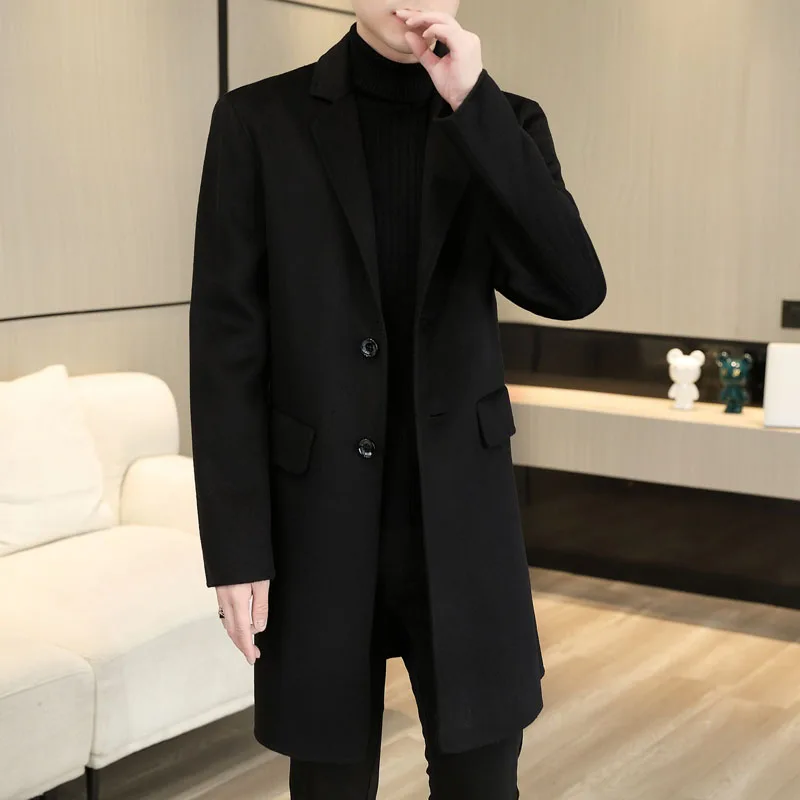
Excellent wool car coat options exist at more accessible price points, offering thoughtful compromises that maintain essential quality and performance while achieving greater value. These mid-range selections deliver impressive quality-to-price ratios through strategic material choices and focused construction.
The Urban Navigator
* Materials: 80% wool/20% polyamide blend at 620 GSM with quilted polyester lining
* Construction Highlights: Reinforced buttonholes, clean seam finishing, substantial collar construction
* Design Elements: Three-button front with wind flap, angled hand-warmer pockets, interior chest pocket
* Fit Profile: Modern silhouette with slight waist suppression; true to size with room for light layering
* Color Options: Charcoal herringbone, navy, and dark olive
* Value Proposition: The strategic blend maintains excellent insulation and appearance while improving wrinkle resistance and reducing cost; construction focuses quality elements where they matter most for performance
The Versatile Classic
* Materials: 70% wool/30% recycled polyester blend at 580 GSM with twill lining
* Construction Highlights: Durable melton fabric with tight weave, clean buttonholes, properly finished interior seams
* Design Elements: Four-button front with notched lapel, flap pockets, back vent for ease of movement
* Fit Profile: Traditional fit with room throughout chest and shoulders; comfortably accommodates business attire
* Color Options: Navy, dark gray, and camel
* Value Proposition: Offers impressive durability and wind resistance at a moderate price point; the recycled content provides both environmental benefits and improved performance
These mid-range options make strategic compromises that preserve the essential qualities that define a good wool car coat. The wool blend fabrics in Metro Cloak’s wool blend collection maintain excellent insulation and appearance while improving durability and reducing cost. Construction focuses quality elements where they matter most for performance and longevity—sturdy seams, proper button attachment, and clean finishing—while simplifying less visible elements.
These value-oriented selections typically offer 5-7 years of regular wear with proper care—a shorter lifespan than premium options but still representing excellent value given their more accessible price points. They perform admirably in most winter conditions while maintaining a sophisticated appearance that belies their reasonable cost.
C. Specialized Picks: Coats for Specific Needs & Conditions
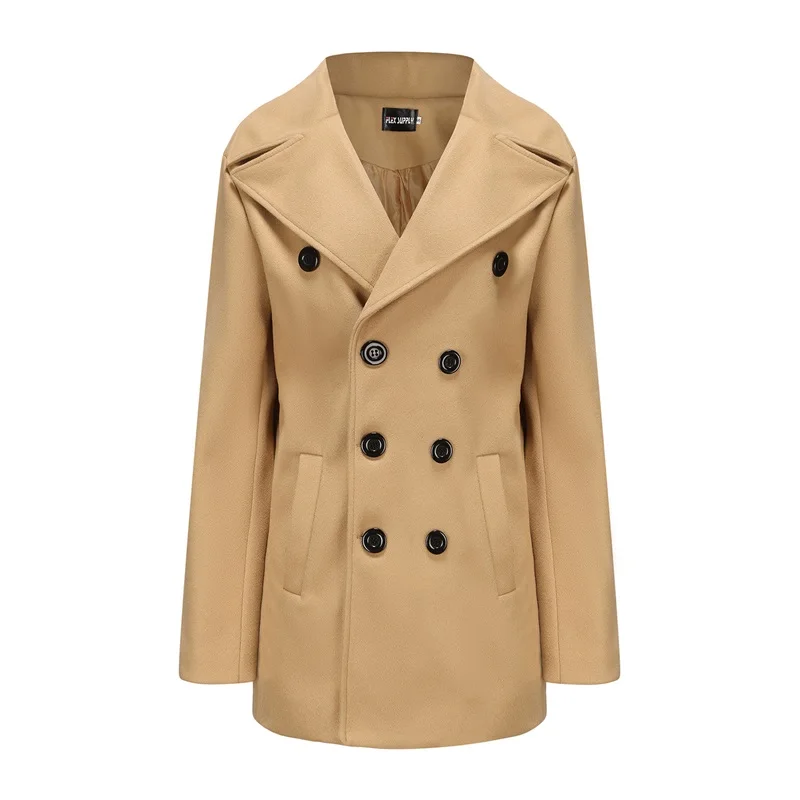
Different lifestyles and climates demand specialized features in wool car coats. These recommendations address specific needs with thoughtful design elements and material selections optimized for particular conditions.
For Extreme Cold: The Northern Defender
* Materials: 85% wool/15% nylon at 800 GSM with Thinsulate™ interlining and flannel lining
* Key Features: Extra-high convertible collar with throat latch, internal wind cuffs, extended back length
* Performance Highlights: Effective in temperatures down to 0°F (-18°C) with appropriate layering; reinforced placket creates double-barrier against wind
* Best For: Severe winter regions, extended outdoor exposure, commuters in extremely cold climates
From Metro Cloak’s heavy winter coat collection, this option maximizes protection without sacrificing style. The strategic material blend improves wind resistance while the specialized insulation system creates exceptional warmth without excessive bulk.
For Daily Commuting: The Urban Transit
* Materials: 70% wool/30% polyester at 650 GSM with water-resistant finish and breathable lining
* Key Features: Action back pleats for movement, reflective detail under collar for visibility, internal media pocket
* Performance Highlights: Stain-resistant treatment repels water and slush; reinforced stress points withstand daily backpack wear
* Best For: Daily public transportation users, active urban lifestyles, variable weather conditions
This commuter-focused design addresses the specific challenges of daily urban transit—frequent temperature changes, unexpected precipitation, and the need for both protection and professional appearance.
For Formal Occasions: The Distinguished Diplomat
* Materials: 90% wool/10% cashmere at 620 GSM with silk-blend lining
* Key Features: Clean silhouette with minimal external details, precisely tailored proportions, covered placket
* Performance Highlights: Elegant drape that complements formal attire; refined texture appropriate for significant occasions
* Best For: Professional environments, formal winter events, business travel
From Metro Cloak’s dress coat selection, this refined option maintains warmth while prioritizing sophisticated appearance. The simplified exterior details create a cleaner silhouette particularly appropriate for formal environments.
For Versatile Lifestyle: The Everyday Elegance
* Materials: 80% wool/20% nylon at 650 GSM with Bemberg lining
* Key Features: Convertible lapel/collar, adaptable button stance, neutral color with subtle texture
* Performance Highlights: Performs well across diverse settings; offers excellent temperature regulation for varied conditions
* Best For: Varied lifestyle with mixed casual/formal needs, frequent travelers, transitional season wear
This adaptable design excels in multiple contexts, from weekend outings to professional settings. The thoughtful design allows for different styling approaches, making it particularly valuable for those with diverse wardrobe needs.
Mens Heavy Winter Coat, Mens Insulated Coat, Mens Parka Coat
Price range: $175.52 through $237.36 Select options This product has multiple variants. The options may be chosen on the product pageMens Big and Tall Winter Coats, Mens Down Coat, Mens Hooded Winter Coat, Mens Puffer Coat
Price range: $126.44 through $217.01 Select options This product has multiple variants. The options may be chosen on the product pageMens Big and Tall Winter Coats, Mens Hooded Winter Coat
Price range: $80.32 through $106.68 Select options This product has multiple variants. The options may be chosen on the product pageMens Double Breasted Pea Coat, Mens Wool Blend Coat, Mens Wool Pea Coat
Price range: $136.84 through $157.36 Select options This product has multiple variants. The options may be chosen on the product pageMens Cashmere Overcoat, Mens Hooded Winter Coat, Mens Wool Blend Coat
Price range: $128.72 through $139.68 Select options This product has multiple variants. The options may be chosen on the product pageMens Hooded Winter Coat, Mens Insulated Coat, Mens Puffer Coat, Mens Quilted Coat
Price range: $139.88 through $177.72 Select options This product has multiple variants. The options may be chosen on the product page
Mastering Wool Car Coat Style: Versatile Styling Approaches
A. Elevated Casual: Weekend & Leisure Ensembles
The wool car coat brings refined elegance to casual settings, elevating weekend and leisure outfits with its structured silhouette and rich texture. For successful casual styling, pair your coat with quality fundamentals that complement its sophisticated character while maintaining comfort.
A charcoal wool car coat creates an effortlessly stylish weekend ensemble when worn with dark indigo jeans, a cream cable-knit sweater, and brown leather chukka boots. This combination balances casual comfort with subtle refinement—perfect for weekend brunches, casual gatherings, or gallery visits. Accessorize with a simple cashmere scarf in a complementary tone to add warmth and visual interest.
For a more contemporary casual approach, pair a navy herringbone car coat with olive chinos, a light gray merino wool crewneck, and white leather sneakers. This outfit works beautifully for weekend errands, casual dinners, or travel, with the coat adding structure to an otherwise relaxed combination. The textural contrast between smooth wool, knitted merino, and twill chinos creates visual depth without requiring bold colors.
When styling wool car coats casually, texture becomes a powerful tool for creating interest while maintaining sophistication. Consider these texture combinations:
– Wool coat + chunky knit sweater + smooth denim
– Wool coat + fine gauge merino + textured chinos
– Wool coat + flannel shirt + corduroy pants
For casual settings, don’t hesitate to try more relaxed accessorizing—knitted beanies, casual leather gloves, and textured scarves all pair beautifully with wool car coats while maintaining the coat’s inherent elegance. The key is balancing the coat’s refinement with appropriately casual elements to avoid appearing overdressed.
For more inspiration on versatile styling approaches, explore comprehensive wool car coat styling guides that showcase the range of casual possibilities.
B. Smart Business & Professional Attire
The wool car coat finds perhaps its most natural home in business and professional contexts, where its refined character complements workplace attire perfectly. For business environments, focus on creating cohesive color stories and appropriate texture relationships between your coat and underlying garments.
For traditional business settings, pair a navy wool car coat with a gray suit, light blue shirt, and burgundy tie. This classic combination works across diverse professional environments, from finance to law to corporate settings. The coat’s structured silhouette enhances the suit’s clean lines, creating a cohesive professional appearance. Consider dark brown leather gloves and a solid scarf in a complementary color to complete the ensemble.
For business-casual environments, a charcoal herringbone car coat works beautifully with navy wool trousers, a light gray cashmere sweater over a white oxford shirt, and brown leather derby shoes. This approach maintains professionalism while introducing subtle texture through the herringbone pattern. The layering creates practical warmth while allowing for adaptation to varying indoor temperatures throughout the workday.
Color coordination becomes particularly important in professional settings. Create harmony by keeping your coat within the same color family as your suit or choosing a complementary neutral. A navy coat works well with gray suits, while charcoal coats complement navy suits beautifully. Camel coats offer more contrast and pair exceptionally well with navy or charcoal business attire for those comfortable with a bolder approach.
Proper layering is essential for commuting comfort. Your coat should allow enough room for a suit jacket without feeling constrained, particularly across the shoulders and chest. When transitioning between outdoors and heated offices, focus on pieces that can be easily adjusted—scarves that can be loosened or removed, gloves that store compactly, and quarters with suitable coat storage.
For additional guidance on incorporating wool outerwear into professional wardrobes, explore resources on winter warmth and style with wool overcoats that address specific professional contexts.
C. Formal Occasion Styling: Making a Refined Statement

For formal winter events, a wool car coat serves as both practical protection and a sophisticated style element that enhances your overall appearance. The key to formal styling lies in precision—ensuring proper proportion relationships between your coat and formal attire while selecting appropriate accessories that maintain elegance.
A navy wool car coat creates a striking formal ensemble when paired with a charcoal suit, white shirt, and burgundy accessories (tie and pocket square). This combination offers subtle color harmony while allowing the refined texture of quality wool to create visual interest. For evening events, this approach conveys sophistication without appearing overly dramatic.
For black-tie optional events where outerwear remains visible during arrivals, consider a black or charcoal wool car coat with a subtle herringbone pattern over a black suit with appropriate formal accessories. The textural interest of the herringbone adds dimension to an otherwise monochromatic palette, creating subtle sophistication.
When wearing a wool car coat over formal attire, proportion relationships become critical. The coat should be long enough to completely cover your suit jacket or blazer, typically extending 2-3 inches (5-7.6 cm) beyond the jacket hem. Sleeve length should allow approximately ¼ inch (0.6 cm) of shirt cuff to show when standing naturally with arms at your sides.
For elegant accessorizing with formal ensembles, consider:
– Fine cashmere scarves in subtle patterns that complement your tie or pocket square
– Leather dress gloves in colors that coordinate with your footwear (black or dark brown)
– Simple pocket squares that echo colors from your scarf without direct matching
Proper coat etiquette for formal events includes removing your coat promptly upon arrival and checking it when facilities exist. When coat check isn’t available, fold your coat carefully along its center back seam and place it flat over the back of your chair rather than bunching it behind you.
Care & Maintenance: Preserving Your Wool Coat Investment
A. Essential Cleaning & Stain Management
Proper cleaning practices significantly extend your wool car coat’s life while maintaining its appearance and insulating properties. For routine maintenance, brush your coat regularly with a natural bristle clothes brush, using gentle downward strokes to remove surface dirt and debris before it becomes embedded in the fibers. This simple practice minimizes the need for more invasive cleaning.
When spot cleaning becomes necessary, act quickly but gently. For liquid spills, blot (don’t rub) with a clean, dry cloth to absorb as much liquid as possible. For specific stains:
– Salt stains: Mix one tablespoon white vinegar with two cups water, dampen a clean cloth, and gently blot the affected area, then allow to dry naturally
– Food stains: Use a dull knife to gently remove any solid material, then blot with cold water before the stain sets
– Oil-based stains: Apply a small amount of cornstarch or talcum powder to absorb oil, let sit for several hours, then brush away
Reserve professional dry cleaning for significant soiling or end-of-season cleaning, typically limiting it to once annually unless unusual circumstances require more frequent treatment. Excessive dry cleaning can degrade wool fibers and remove natural oils that contribute to the fabric’s performance. When selecting a dry cleaner, choose one experienced with wool outerwear and specify that you want to preserve the fabric’s natural characteristics.
Between cleanings, manage odors by hanging your coat in fresh air away from direct sunlight for several hours. For persistent odors, consider a fabric refresher specifically formulated for wool, testing first in an inconspicuous area to ensure no adverse reaction.
B. Proper Storage Techniques for Longevity
Proper off-season storage significantly impacts your wool coat’s longevity. Before storing, ensure your coat is completely clean and dry, as even invisible soiling can attract moths and cause degradation over time. Allow at least 24 hours after final wearing before storing to ensure any moisture from wear has evaporated.
The ideal storage environment features:
– Consistent, cool temperatures (below 75°F/24°C)
– Moderate humidity (around 50%)
– Protection from direct sunlight, which can fade colors and degrade fibers
– Good air circulation to prevent mustiness
For hanging storage, use a sturdy, broad-shouldered wooden or padded hanger that supports the coat’s shape without creating pressure points. Allow adequate space around the coat rather than compressing it between other garments. Breathable cotton garment bags offer protection from dust while allowing air circulation, making them preferable to plastic covers that can trap moisture.
For moth prevention, cedar products (blocks, hangers, or closet lining) provide natural repellent properties while imparting a pleasant scent. These should be refreshed periodically by light sanding to expose fresh cedar oil. Lavender sachets offer a pleasant alternative with mild moth-deterrent properties.
Before returning your coat to regular use after storage, air it thoroughly and inspect for any issues that might require attention before wearing.
C. Routine Maintenance for Sustained Performance
Establishing a seasonal maintenance routine preserves your wool car coat’s appearance and performance. At the beginning of each wearing season, inspect your coat thoroughly for any needed repairs or refreshing. Throughout the season, implement these practices for optimal condition:
Weekly brushing with a natural bristle clothing brush removes surface dirt and revitalizes the nap of the wool. Brush in downward strokes, paying particular attention to areas that collect dust and debris: collar, shoulders, and front panels. This simple practice prevents dirt from becoming embedded and maintains the fabric’s appearance.
Address minor repairs promptly before they escalate into larger issues:
– Loose buttons: Reinforce with matching thread before they detach completely
– Small seam openings: Repair with matching thread using small, careful stitches
– Minor lining tears: Patch or stitch promptly to prevent spreading
For wrinkle management, use steam rather than direct ironing whenever possible. Hang your coat in a steamy bathroom or use a garment steamer held several inches from the fabric, allowing the steam to penetrate and relax fibers. If ironing becomes necessary, use the wool setting with a pressing cloth between the iron and fabric, working from the inside whenever possible.
Consider applying a wool-specific fabric protector at the beginning of each season to enhance water and stain resistance. These products create an invisible barrier that repels moisture and prevents stains from setting while maintaining the fabric’s breathability. Always test on an inconspicuous area first and follow manufacturer instructions carefully.
Is a Wool Car Coat Right for You? Making Your Final Decision
A wool car coat represents a significant investment in your winter wardrobe—one that delivers exceptional returns through its versatility, performance, and longevity when properly selected. As you consider this purchase, reflect on the unique advantages wool car coats offer: natural insulation that maintains warmth without bulk, adaptability across both casual and formal contexts, and timeless styling that resists trends.
Your personal needs and lifestyle should guide your decision. Consider these factors when determining if a wool car coat aligns with your requirements:
- Climate Considerations: Wool car coats excel in moderate to cold winter conditions, particularly in temperatures from 25-45°F (-4 to 7°C). For extremely cold regions, look for heavier weights or specialized insulation.
- Professional Requirements: If your work demands a polished appearance, a wool car coat offers professional presentation while providing practical warmth for commuting.
- Lifestyle Patterns: Consider your typical activities—wool car coats work beautifully for urban environments with mixed indoor/outdoor transitions but may prove less practical for extended outdoor activities in severe conditions.
- Existing Wardrobe: Evaluate how a wool car coat would complement your current clothing. These coats pair especially well with business attire and smart casual ensembles.
While wool car coats offer remarkable versatility, they may not be ideal for every situation. Their structured silhouette and mid-thigh length may feel too formal for very casual settings, and they typically provide insufficient protection for extreme weather conditions that require specialized technical outerwear.
The long-term value proposition of quality wool outerwear deserves consideration. A well-constructed wool car coat often provides 7-15+ years of service with proper care—significantly longer than most synthetic alternatives. This longevity, combined with natural materials that age gracefully, creates compelling value despite higher initial investment.
For additional insights on determining appropriate warmth levels for your specific needs, explore guides on decoding winter coat warmth that help match insulation to your climate requirements.
Frequently Asked Questions About Wool Car Coats
How do I know if a wool car coat will be warm enough for my climate?
Wool coat warmth correlates primarily with fabric weight and construction. For mild winter regions (temperatures rarely below freezing), lightweight options (400-600 GSM) generally provide sufficient protection. Moderate winter climates benefit from medium-weight coats (600-700 GSM), while severe winter regions require heavyweight options (700+ GSM) or additional insulation. Consider your typical activities as well—commuting short distances requires less insulation than extended outdoor exposure.
Can wool car coats be worn in light rain or snow?
Yes, with some limitations. Wool naturally repels light moisture thanks to its lanolin content and fiber structure. Tightly woven wool (like melton) performs better in wet conditions than looser weaves. Brief exposure to light rain or snow is typically fine, with moisture beading on the surface rather than immediately penetrating. However, prolonged exposure will eventually saturate the fabric. For improved water resistance, consider wool car coats with water-resistant treatments or higher synthetic content in the blend.
How should a wool car coat fit over a suit or blazer?
A properly fitted car coat allows comfortable movement while maintaining a clean silhouette. When trying on over a suit jacket or blazer, ensure you can button the coat without pulling or strain across the chest and shoulders. The sleeves should extend slightly beyond your suit jacket, typically showing ¼-½ inch (0.6-1.3 cm) of shirt cuff. The coat length should fully cover your suit jacket by 2-3 inches (5-7.6 cm). If you’ll primarily wear your coat over tailored clothing, consider trying your regular size and one size larger to determine which provides the best layering comfort.
Are wool blends significantly less warm than 100% wool coats?
Not necessarily. While pure wool offers excellent natural insulation, quality wool blends (typically 70-90% wool) can provide comparable warmth while adding beneficial properties. Nylon or polyester content often improves wind resistance and durability, potentially enhancing overall warmth in windy conditions. The weave, weight, and construction influence warmth more significantly than small differences in wool percentage. However, blends with less than 60% wool may show noticeable differences in insulation performance.
How long should a quality wool car coat last with proper care?
With appropriate maintenance, quality wool car coats deliver exceptional longevity. Premium options with superior construction typically provide 10-15+ years of regular winter wear. Mid-range quality coats generally deliver 5-10 years of service. Factors affecting longevity include wearing frequency, care practices, storage methods, and exposure conditions. Regular brushing, prompt attention to stains, limited dry cleaning, and proper off-season storage significantly extend a coat’s useful life.

